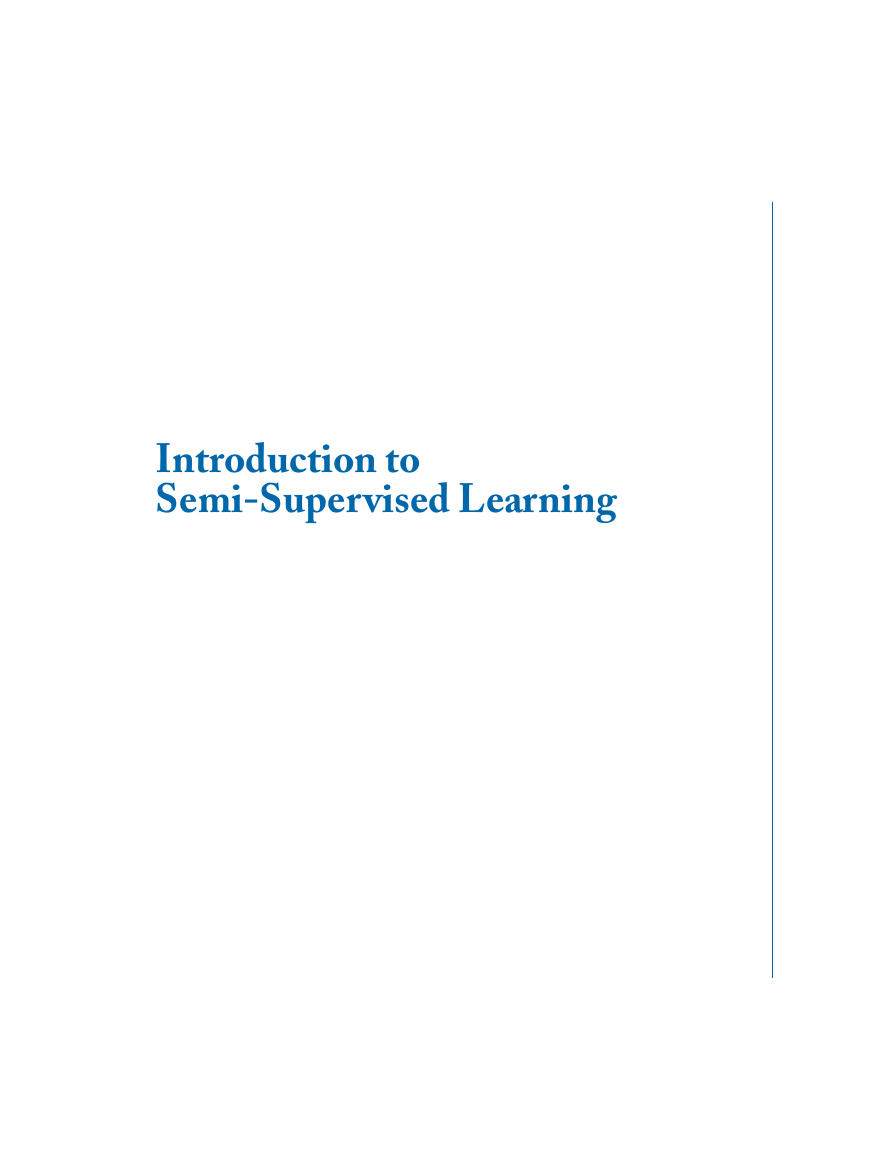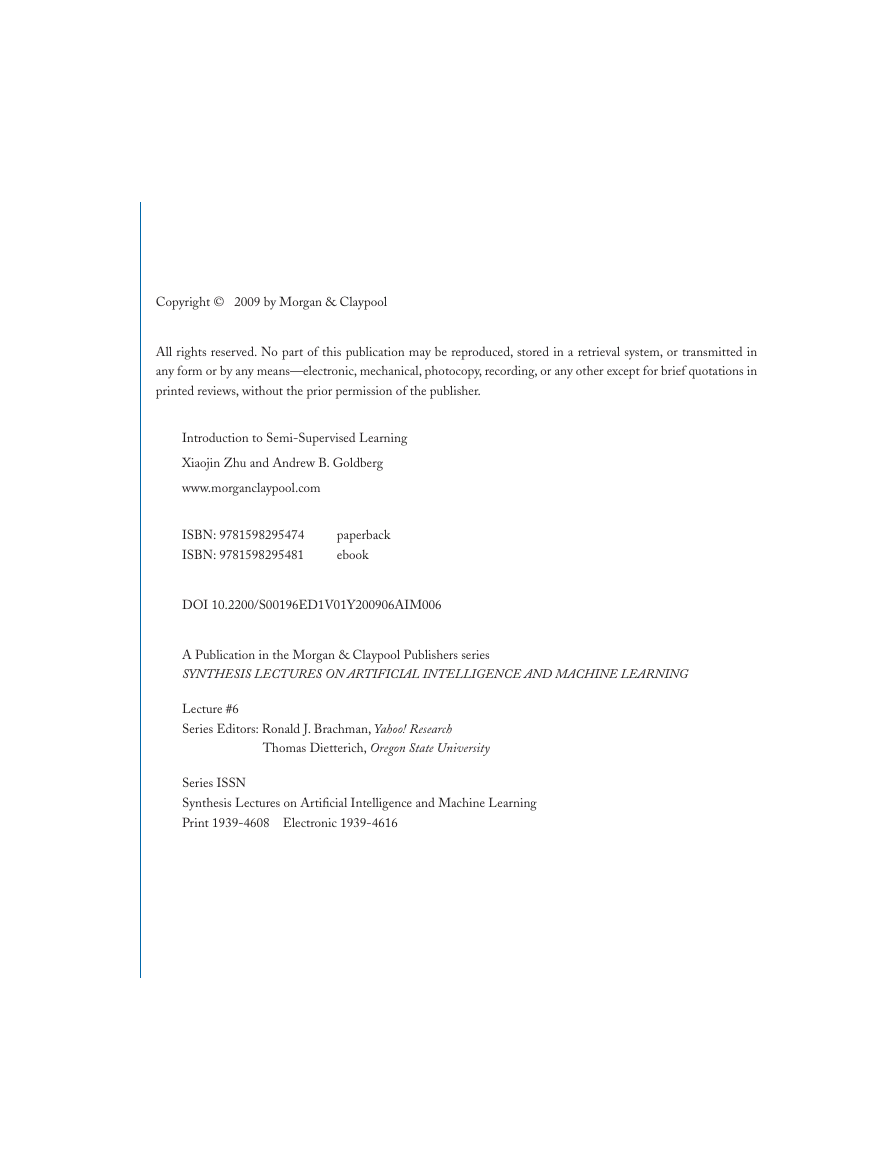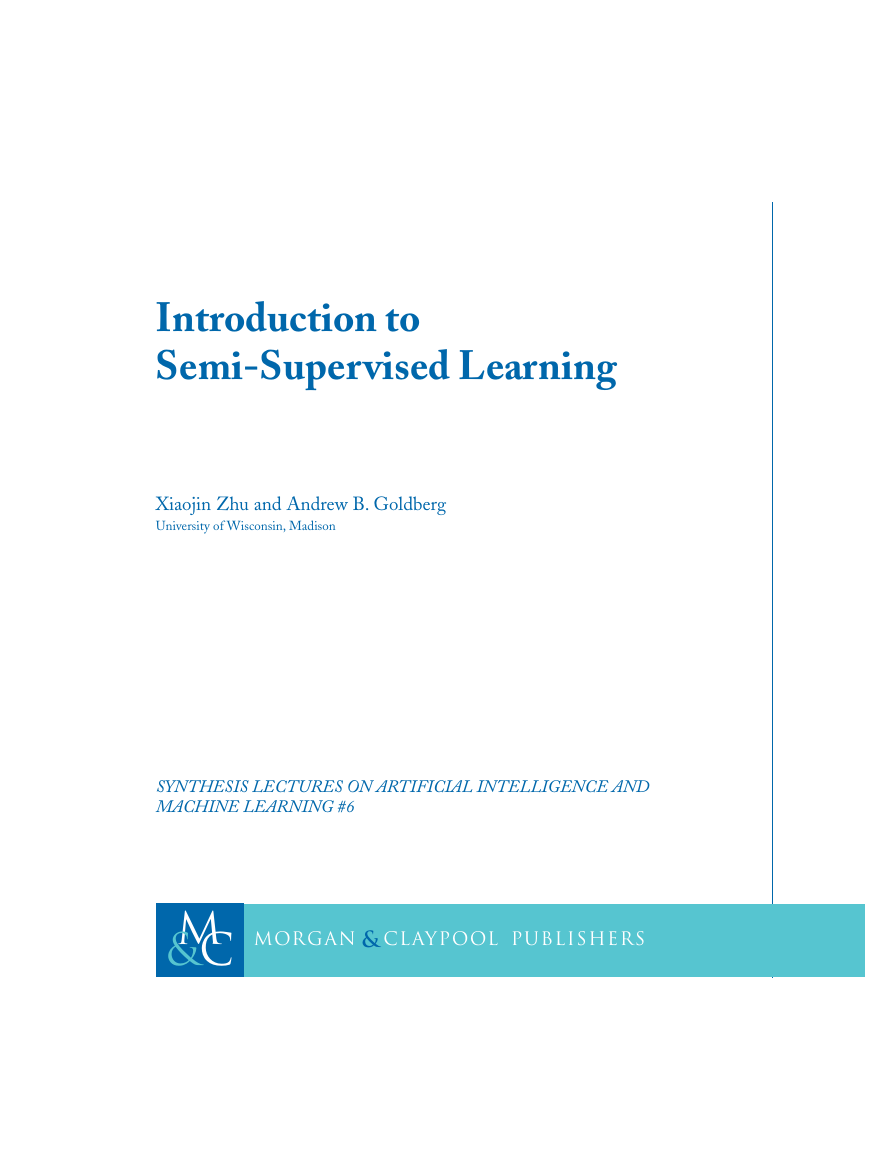Introduction to
Semi-Supervised Learning
�
�
Synthesis Lectures on
Artificial Intelligence and
Machine Learning
Editors
Ronald J. Brachman, Yahoo! Research
Thomas Dietterich, Oregon State University
Introduction to Semi-Supervised Learning
Xiaojin Zhu and Andrew B. Goldberg
2009
Action Programming Languages
Michael Thielscher
2008
Representation Discovery using Harmonic Analysis
Sridhar Mahadevan
2008
Essentials of Game Theory: A Concise Multidisciplinary Introduction
Kevin Leyton-Brown, Yoav Shoham
2008
A Concise Introduction to Multiagent Systems and Distributed Artificial Intelligence
Nikos Vlassis
2007
Intelligent Autonomous Robotics: A Robot Soccer Case Study
Peter Stone
2007
�
Copyright © 2009 by Morgan & Claypool
All rights reserved. No part of this publication may be reproduced, stored in a retrieval system, or transmitted in
any form or by any means—electronic, mechanical, photocopy, recording, or any other except for brief quotations in
printed reviews, without the prior permission of the publisher.
Introduction to Semi-Supervised Learning
Xiaojin Zhu and Andrew B. Goldberg
www.morganclaypool.com
ISBN: 9781598295474
ISBN: 9781598295481
paperback
ebook
DOI 10.2200/S00196ED1V01Y200906AIM006
A Publication in the Morgan & Claypool Publishers series
SYNTHESIS LECTURES ON ARTIFICIAL INTELLIGENCE AND MACHINE LEARNING
Lecture #6
Series Editors: Ronald J. Brachman, Yahoo! Research
Thomas Dietterich, Oregon State University
Series ISSN
Synthesis Lectures on Artificial Intelligence and Machine Learning
Print 1939-4608 Electronic 1939-4616
�
Introduction to
Semi-Supervised Learning
Xiaojin Zhu and Andrew B. Goldberg
University of Wisconsin, Madison
SYNTHESIS LECTURES ON ARTIFICIAL INTELLIGENCE AND
MACHINE LEARNING #6
CM&
Morgan
&
cLaypool
publishers
�
ABSTRACT
Semi-supervised learning is a learning paradigm concerned with the study of how computers and
natural systems such as humans learn in the presence of both labeled and unlabeled data.Traditionally,
learning has been studied either in the unsupervised paradigm (e.g., clustering, outlier detection)
where all the data is unlabeled, or in the supervised paradigm (e.g., classification, regression) where
all the data is labeled. The goal of semi-supervised learning is to understand how combining labeled
and unlabeled data may change the learning behavior, and design algorithms that take advantage
of such a combination. Semi-supervised learning is of great interest in machine learning and data
mining because it can use readily available unlabeled data to improve supervised learning tasks when
the labeled data is scarce or expensive. Semi-supervised learning also shows potential as a quantitative
tool to understand human category learning, where most of the input is self-evidently unlabeled.
In this introductory book, we present some popular semi-supervised learning models, including
self-training, mixture models, co-training and multiview learning, graph-based methods, and semi-
supervised support vector machines. For each model, we discuss its basic mathematical formulation.
The success of semi-supervised learning depends critically on some underlying assumptions. We
emphasize the assumptions made by each model and give counterexamples when appropriate to
demonstrate the limitations of the different models. In addition, we discuss semi-supervised learning
for cognitive psychology. Finally, we give a computational learning theoretic perspective on semi-
supervised learning, and we conclude the book with a brief discussion of open questions in the
field.
KEYWORDS
semi-supervised learning, transductive learning, self-training, Gaussian mixture model,
expectation maximization (EM), cluster-then-label, co-training, multiview learning,
mincut, harmonic function, label propagation, manifold regularization, semi-supervised
support vector machines (S3VM), transductive support vector machines (TSVM), en-
tropy regularization, human semi-supervised learning
�
To our parents
Yu and Jingquan
Susan and Steven Goldberg
with much love and gratitude.
�
�
















 2023年江西萍乡中考道德与法治真题及答案.doc
2023年江西萍乡中考道德与法治真题及答案.doc 2012年重庆南川中考生物真题及答案.doc
2012年重庆南川中考生物真题及答案.doc 2013年江西师范大学地理学综合及文艺理论基础考研真题.doc
2013年江西师范大学地理学综合及文艺理论基础考研真题.doc 2020年四川甘孜小升初语文真题及答案I卷.doc
2020年四川甘孜小升初语文真题及答案I卷.doc 2020年注册岩土工程师专业基础考试真题及答案.doc
2020年注册岩土工程师专业基础考试真题及答案.doc 2023-2024学年福建省厦门市九年级上学期数学月考试题及答案.doc
2023-2024学年福建省厦门市九年级上学期数学月考试题及答案.doc 2021-2022学年辽宁省沈阳市大东区九年级上学期语文期末试题及答案.doc
2021-2022学年辽宁省沈阳市大东区九年级上学期语文期末试题及答案.doc 2022-2023学年北京东城区初三第一学期物理期末试卷及答案.doc
2022-2023学年北京东城区初三第一学期物理期末试卷及答案.doc 2018上半年江西教师资格初中地理学科知识与教学能力真题及答案.doc
2018上半年江西教师资格初中地理学科知识与教学能力真题及答案.doc 2012年河北国家公务员申论考试真题及答案-省级.doc
2012年河北国家公务员申论考试真题及答案-省级.doc 2020-2021学年江苏省扬州市江都区邵樊片九年级上学期数学第一次质量检测试题及答案.doc
2020-2021学年江苏省扬州市江都区邵樊片九年级上学期数学第一次质量检测试题及答案.doc 2022下半年黑龙江教师资格证中学综合素质真题及答案.doc
2022下半年黑龙江教师资格证中学综合素质真题及答案.doc